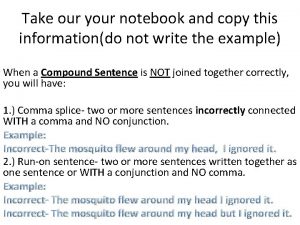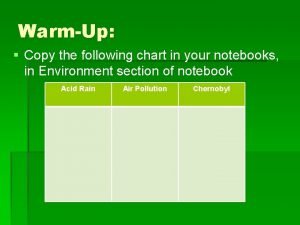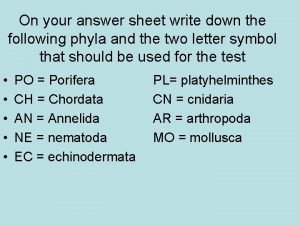Warm Up Copy the question in your warm







- Slides: 7

Warm Up: Copy the question in your warm up section of your binder. 1. What causes earthquakes and tsunamis?

Volcanoes • Volcano-originates with the Roman god of fire, Vulcan. • Place on the Earth’s surface where molten rock, gases and pyroclastic debris erupt through the earth's crust. • Vary quite a bit in their structure - some are cracks in the earth's crust where lava erupts, and some are domes, shields, or mountainlike structures with a crater at the summit. • Magma is molten rock within the Earth's crust. When magma erupts through the earth's surface it is called lava. • Lava can be thick and slow-moving or thin and fast-moving. • Rock also comes from volcanoes in other forms, including ash (finely powdered rock that looks like dark smoke coming from the volcano), cinders (bits of fragmented lava), and pumice (lightweight rock that is full of air bubbles and is formed in explosive volcanic eruptions - this type of rock can float on water).

Mt. St. Helens, Washington

Mt. St. Helen Erupts http: //youtu. be/nj. V 9 ski 1 g. B 4

Mt. St. Helens

What Caused the Eruption?

Aftermath • 57 people were killed and 200 houses, 27 bridges, 15 miles (24 km) of railways and 185 miles (300 km) of highway were destroyed • The removal of the north side of the mountain reduced St. Helens' height by about 1, 313 feet (400 m) and left a crater 1 to 2 miles (2 to 3 km) wide and 2, 100 feet (640 m) deep • As many as 1, 500 elk and 5, 000 deer were killed, and an estimated 12 million Chinook and Coho salmon fingerlings died when their hatcheries were destroyed. • 4 billion board feet (14. 6 km³) of timber was damaged or destroyed, mainly by the lateral blast. • in areas of thick ash accumulation, many agricultural crops, such as wheat, apples, potatoes and alfalfa, were destroyed













